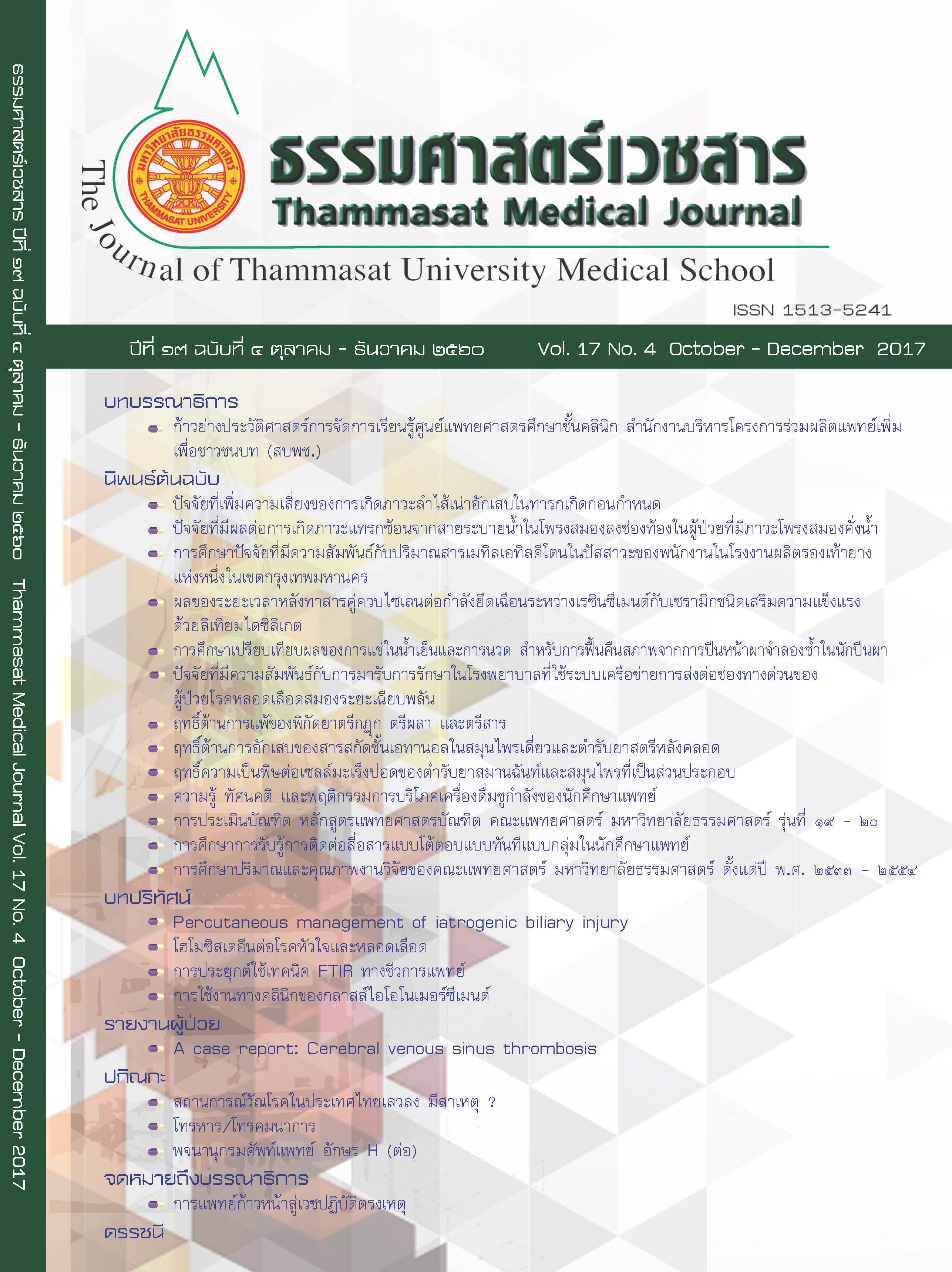Effect of post-silanization time intervals on shear bond strength of resin cement to lithium disilicate-reinforced glass ceramic
Keywords:
Lithium disilicate-reinforced glass ceramic, Resin cement, Shear bond strength, Silane coupling agent, เซรามิกชนิดเสริมความแข็งแรงด้วยลิเทียมไดซิลิเกต, เรซินซีเมนต์, กำลังยึดเฉือน, สารคู่ควบไซเลนAbstract
Introduction: The purpose of this study was to compare shear bond strength between resin cement and lithium disilicate-reinforced glass ceramic varying time intervals after silane application prior to bonding.
Method: Forty lithium disilicate -reinforced glass ceramic discs (6 mm diameter, 3 mm thick) were embedded into PVC pipes using dental gypsum. To create uniform flat surfaces for bonding, the ceramic surfaces were sequentially polished with wet 400- and 600- grit SiC papers. All specimens were cleaned with 35% phosphoric acid, then rinsed with distilled water and dried. They were then randomly divided into four groups (n = 10), according to timing between silanization and adhesive cementation process. No silane treatment was used as a control group (Group 1) while the other three groups were treated with commercial silane solution and stored in the dry sealed containers for 10 minutes (Group 2), 7 days (Group 3) and 14 days (Group 4) before bonded to resin composite with resin cement. All specimens were light-cured for 20 seconds in four directions, kept dry at room temperature for 10 minutes and then immersed in 37 ºC distilled water for 24 hours before subjecting to the shear bond strength test. The shear bond strength test was carried out in a universal testing machine at a crosshead speed of 0.5 mm/min. One-way ANOVA followed by Tukey’s post hoc analysis were used to analyze the differences in the bond strength values based on the time intervals between silanization and the adhesive cementation process at the 95% level of confidence. The fractured surfaces were examined under a stereomicroscope at 40X magnification in order to determine the mode of failure.
Result: The mean shear bond strengths between resin cement and lithium disilicate-reinforced glass ceramic of Group 1 to Group 4 were 1.79 ± 1.20, 15.01 ± 4.03, 16.49 ± 5.97, 15.61 ± 6.40 MPa, respectively. Group 1 showed significantly lower shear bond strength compared with Group 2, Group 3 and Group 4
(p < 0.05). No significant differences in shear bond strengths were found among silanization groups (Group 2, Group 3 and Group 4) (p > 0.05). Even though mixed failure mode was mostly found in this study, cohesive failure in the resin cement was more noticeable than adhesive failure in each sample.
Discussion and Conclusion: Silanated surface treatment of lithium disilicate-reinforced glass
ceramic significantly improved the shear bond strength between lithium disilicate-reinforced glass ceramic and resin cement, regardless of the post-silanization time intervals (10 minutes - 14 days) before bonded to resin cement.
บทคัดย่อ
บทนำ: การศึกษานี้มีวัตถุประสงค์เพื่อเปรียบเทียบกำลังยึดเฉือนระหว่างเรซินซีเมนต์กับเซรามิกชนิดเสริมความแข็งแรงด้วยลิเทียมไดซิลิเกตเมื่อทาสารคู่ควบไซเลนแล้วทิ้ง ไว้ในเวลาที่แตกต่างกันก่อนยึดด้วยเรซินซีเมนต์
วิธีการศึกษา: นำแผ่นเซรามิกชนิดเสริมความแข็งแรงด้วยลิเทียมไดซิลิเกตขนาดเส้นผ่านศูนย์กลาง ๖ มิลลิเมตร หนา ๓ มิลลิเมตร จำนวน ๔๐ ชิ้น ฝังลงในท่อพีวีซีด้วยยิปซัมทางทันตกรรม ขัดผิวหน้าชิ้น ทดสอบให้เรียบด้วยกระดาษซิลิกอนคาร์ไบด์ที่มีความหยาบ ๔๐๐ และ ๖๐๐ กริท ตามลำดับ ทากรดฟอสฟอริกความเข้มข้นร้อยละ ๓๕ บนผิวหน้าของชิ้น ทดสอบล้างด้วยน้ำ กลั่น และเป่าให้แห้ง แบ่งชิ้นทดสอบแบบสุ่มเป็น ๔ กลุ่ม กลุ่มละ ๑๐ ชิ้น ตามระยะเวลาหลังทาสารคู่ควบไซเลนบนชิ้นทดสอบก่อนยึดแท่งเรซินคอมโพสิตด้วยเรซินซีเมนต์ดังนี้ กลุ่มที่ ๑ ไม่ทาสารคู่ควบไซเลนเป็นกลุ่มควบคุม กลุ่มที่ ๒, ๓ และ ๔ ทาสารคู่ควบไซเลนและทิ้งไว้ในภาชนะแห้งที่มีฝาปิดเป็นเวลา ๑๐ นาที ๗ วัน และ
๑๔ วัน ตามลำดับ ยึดแท่งเรซินคอมโพสิตบนผิวหน้าชิ้นทดสอบในแต่ละกลุ่มด้วยเรซินซีเมนต์ ฉายแสงทั้งสี่ด้านของชิ้น ทดสอบด้านละ ๒๐ วินาที วางชิ้น ทดสอบที่อุณหภูมิห้องเป็นเวลา ๑๐ นาที แช่ชิ้นทดสอบในน้ำ กลั่นและเก็บไว้ในตู้ควบคุมอุณหภูมิที่ ๓๗ องศาเซลเซียส เป็นเวลา ๒๔ ชั่วโมงก่อนการทดสอบกำลังยึดเฉือนด้วยเครื่องทดสอบแรงสากลด้วยความเร็วหัวกด ๐.๕ มิลลิเมตรต่อนาที นำข้อมูลที่ได้มาวิเคราะห์ทางสถิติโดยใช้การวิเคราะห์ความแปรปรวนทางเดียวและเปรียบเทียบความแตกต่างระหว่างกลุ่มด้วยการเปรียบเทียบเชิงซ้อนชนิดทูกี้ที่ระดับความเชื่อมั่นร้อยละ ๙๕ ศึกษารูปแบบความล้มเหลวด้วยกล้องจุลทรรศน์แบบใช้แสงชนิดสเตอริโอที่กำลังขยาย ๔๐ เท่า
ผลการศึกษา: ค่าเฉลี่ยกำลังยึดเฉือนระหว่างเรซินซีเมนต์กับเซรามิกชนิดเสริมความแข็งแรงด้วยลิเทียมไดซิลิเกตของกลุ่มที่ ๑ ถึงกลุ่มที่ ๔ คือ ๑.๗๙ ± ๑.๒๐, ๑๕.๐๑ ± ๔.๐๓, ๑๖.๔๙ ± ๕.๙๗, ๑๕.๖๑ ± ๖.๔๐ เมกะพาสคาล ตามลำดับ ค่าเฉลี่ยกาลังยึดเฉือนกลุ่มที่ ๑ มีค่าต่ำกว่ากลุ่มที่ ๒ กลุ่มที่ ๓ และกลุ่มที่ ๔ อย่างมีนัยสาคัญทางสถิติ (p < ๐.๐๕) แต่กลุ่มที่ทาสารคู่ควบไซเลนบนชิ้นทดสอบก่อนยึดแท่งเรซินคอมโพสิตด้วยเรซินซีเมนต์ (กลุ่มที่ ๒ ๓ และกลุ่มที่ ๔) มีค่าเฉลี่ยกำลังยึดเฉือนไม่แตกต่างกันอย่างมีนัยสำคัญทางสถิติ (p > ๐.๐๕) ความล้มเหลวส่วนใหญ่เป็นแบบผสม โดยพบการเชื่อมแน่นล้มเหลวในเนื้อวัสดุ
เรซินซีเมนต์มากกว่าความล้มเหลวแบบการไม่ยึดอยู่ในแต่ละชิ้นทดสอบ
วิจารณ์ และสรุปผลการศึกษา: การทาสารคู่ควบไซเลนทำให้กำลังยึดเฉือนระหว่างเซรามิกชนิดเสริมความแข็งแรงด้วยลิเทียมไดซิลิเกตกับเรซินซีเมนต์สูงขึ้น โดยการทาสารคู่ควบไซเลนทิ้งไว้ตั้งแต่ ๑๐ นาทีถึง ๑๔ วันก่อนยึดด้วยเรซินซีเมนต์ให้กำลังยึดเฉือนระหว่างเซรามิกชนิดเสริมความแข็งแรงด้วยลิเทียมไดซิลิเกตกับเรซินซีเมนต์ไม่แตกต่างกัน



